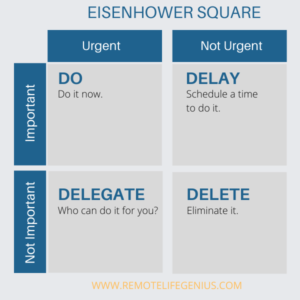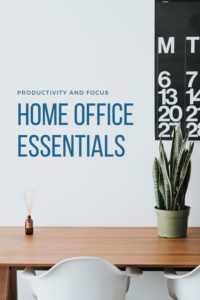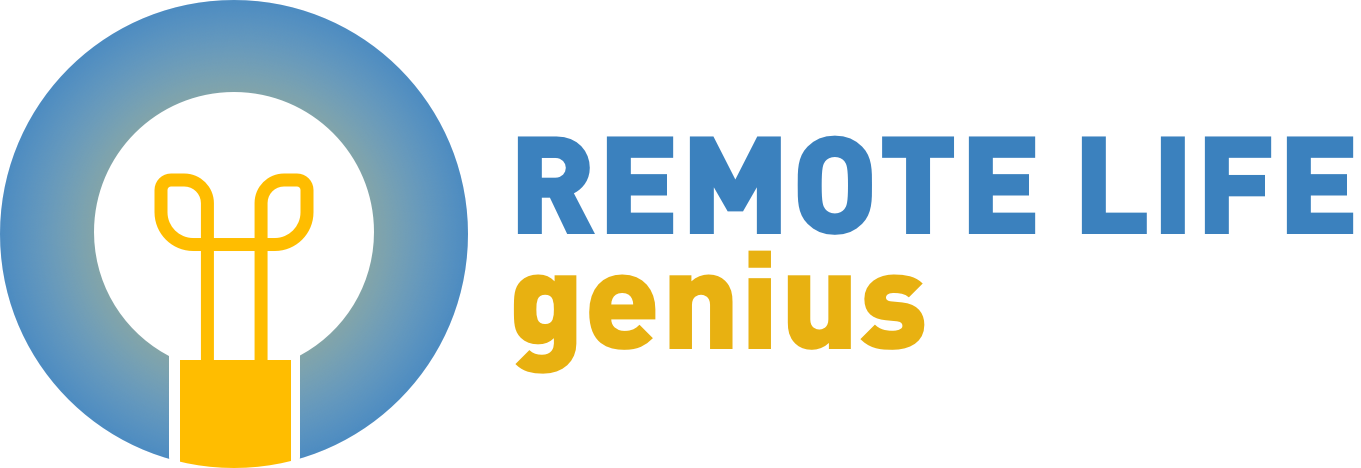
According to Flexjobs,75% of workers believe they would be more productive working remotely. And it’s true, working from home does offer many advantages. No commute, fewer distractions, and a personalized workspace to name a few.
So, where does this extra productivity come from? And does working from home automatically make you more productive?
The answer is not exactly.
Working from home gives you the potential to be more productive. But, it also has its unique challenges and distractions.
People who are more productive working from home get a few things consistently right.
They take steps to stay productive, actively create work-life balance and set up environments that make working from home easier.
We’ll walk you through the basics of being productive while working from home, and creating boundaries for your work and personal life.
Page Contents
Fostering Productivity and Focus

One of the top reasons people choose to work from home is that there are fewer office distractions. It’s easier to focus on work without the temptation to chat with coworkers. But, you can be easily distracted at home too.
Furthermore, when you’re working from home, you don’t have any accountability monitors. There are no managers or coworkers in the room who know what you’re doing. So, while there are fewer distractions, it can be easier to give in to distractions.
At home, the kitchen, tv, and even cleaning can become distractions. It’s important to keep them out of sight and out of mind during the work hours. Here are some of the top ways to stay focused on work while at home.
Create routines
It’s nice to roll out of bed and walk over to your desk in pajamas. But is it the best way to start a productive day? Most likely not.
When you work from home, you get back the extra time you used to spend commuting. Which means you have the time to create a productive morning routine.
 Showering, exercising, and eating a healthy breakfast can all put you into a better work mindset. Or perhaps starting with meditation and reading gets you in the right headspace.
Showering, exercising, and eating a healthy breakfast can all put you into a better work mindset. Or perhaps starting with meditation and reading gets you in the right headspace.
If you have a family or significant other at home, you can also plan to spend some quality time with them before starting the workday.
Whatever gets you focused, make sure you have a routine set up for your mornings. Otherwise, the temptation to sleep in and start lazily can creep in over time.
The same can go for evening and lunch routines. Your mornings will be more productive if you intentionally unwind from your workday the night before.
These don’t need to be rigid. It takes time to find the right balance, but your routines should support you, not suffocate you.
Find your peak productivity hours
When you work from home, you have more freedom to choose your work hours. (If you’re a customer-facing role, you may have less flexibility, but it doesn’t mean you can’t tailor your hours to your advantage.)
Scheduling work during your peak hours lets you get more done in less time. And, all you’re doing is working with the natural flow of your mind and energy.
Once you find your peak hours, block these times out for work.
Peak productivity can mean a couple of different things. For example, research has shown that we are more creative when tired.  So, you can schedule problem-solving for the times your energy lags. However, you want to work on detail-oriented tasks when you are feeling alert.
So, you can schedule problem-solving for the times your energy lags. However, you want to work on detail-oriented tasks when you are feeling alert.
If you don’t know your peak productivity hours, you can try the Natural Rhythm Experiment laid out by Chris Bailey, author of The Productivity Project: Accomplishing More by Managing Your Time, Attention, and Energy.
Bailey recommends running the experiment for a full three weeks to track focus, energy, and motivation. But, even one week can give you good insight.
Try to eliminate things that can affect your energy levels, like going to sleep late or too much caffeine. Then, track your focus and energy levels throughout the day for a week.
You can keep the results in a notebook or on your phone. After one week, you should begin to see a pattern of when you are most productive.
Track goals and tasks
If you’re fully employed but working from home, your company may already have systems in place to track goals and tasks.
However, if you’re freelancing or running your own business, it’s up to you to set goals and track your time. It’s important to track daily objectives as well as long-term goals.
There are two types of deadlines. Soft deadlines are the ones you set for yourself. Hard deadlines are set by your manager or clients. Research shows that using both types of deadlines increases productivity.
For maximum productivity, start by breaking your projects into smaller tasks. Then, use set short deadlines for each task. By doing this, you’ll consistently complete tasks and learn to build momentum in your work.
Keeping a calendar or planner to track your deadlines will hold you accountable. We also recommend using it for both long-term planning and daily task-setting.

Use frameworks to prioritize
The most productive people consistently complete high impact tasks. When working from home, it can be easy to take advantage of extra work time instead of learning to prioritize.
If you get more work done, but it’s not important work you will be productive but not effective.
There are several frameworks that can help you with setting priorities. One popular method is the Eisenhower Matrix. Add each of your tasks to one of the following categories based on urgency (how soon it needs to be done) and importance (how important it is)
- Urgent & Important – Do it now
- Important but not urgent – Delay and do it later
- Urgent but not important – Delegate it
- Not important & not urgent – Delete it
Based on a task’s urgency and importance, you’ll either do it, delay it, delegate it, or delete it. You can use numbers to label the categories on a task list. (For example 1 = urgent and important, 2 = important not urgent, and so forth).

This short exercise will help you decide which tasks need to be completed each day. The coding system can be used on your planner to help you remember.
Other prioritization methods include the ABCDE Method, The Ivy Lee Method, and the One-Three-Five List. Try a couple out and find the best framework that works for you. You may even find that you like to use a couple of them.
Mental Health and Work-Life Balance
Make wellness your goal
Working from home can increase productivity, but it shouldn’t be at the expense of your mental or emotional health. It can be easy to let the lines between work and life blur when it all happens in one space.
If you overdo it at work, you may find yourself burnt out or sacrificing time with loved ones.
When both work and life happen in the same spaces, you need to create boundaries that promote a healthy balance.
Creating balance doesn’t mean you’ll do 50% work and 50% personal life all of the time. But, on average, you should learn to be productive without sacrificing your health. This is what it means to focus on overall wellness.
Your wellness includes productivity at work, physical health, mental health, and emotional health.
We covered work productivity in the first section. So let’s take a look at the others here.
Physical health
One of the benefits of working from home is increased flexibility of time. This is especially helpful for supporting your physical health. For example, including a healthy breakfast and exercise in a morning routine keeps you productive and healthy.
When talking about physical health, the two biggest factors are food and exercise/movement.
When you’re at home, you also have more food options. You can choose to cook during the day rather than purchasing lunch. But, if you keep a kitchen stocked with unhealthy snacks, it’ll be hard to resist grabbing for them during the workday.
Here are some healthy work from home lunch recipes and snack recipes to check out for inspiration.
 As for exercise, you want to create breaks to avoid sitting still for too long. It may seem trivial, but sitting for too long can increase your risk of obesity, diabetes, cardiovascular disease, and other conditions.
As for exercise, you want to create breaks to avoid sitting still for too long. It may seem trivial, but sitting for too long can increase your risk of obesity, diabetes, cardiovascular disease, and other conditions.
At home, make sure to schedule breaks to get up and exercise. Even taking a walk can help relieve the side effects of prolonged sitting.
Mental health
One of the unique challenges to working from home can be guilt and pressure to appear busy. This happens more often for salaried individuals but can apply to anyone.
A survey from SHRM revealed that 62% of remote workers fear that their colleagues don’t believe they are working hard.
Thus, we see the pressure to constantly appear “busy” or “always on”. This means that instead of prioritizing, you find yourself responding to every message as if it’s urgent and important.
And suddenly everyone else’s requests are more important than your tasks, and your sense of worth decreases. It’s a tough pressure that can sneak up on you. However, there are ways to help you stick to your schedule and priorities.
Start by communicating your work schedule with colleagues and clients. Dedicate separate times to check your email, and only check it a couple of times a day.
If this still makes you uncomfortable, give people a way to reach you for urgent tasks only. You may be surprised to find that most tasks are not as urgent as they sound in an email.
And finally, make sure you communicate the work you accomplish. Send your manager regular progress updates, and report your good news and milestones as they happen.
Emotional health
 Working from home can give you relief from your main office stressors, but it’s not always easy. According to Buffer, 21% of workers cite loneliness as the biggest struggle of working from home. Another 21% say that the biggest challenge is collaborating with others from home.
Working from home can give you relief from your main office stressors, but it’s not always easy. According to Buffer, 21% of workers cite loneliness as the biggest struggle of working from home. Another 21% say that the biggest challenge is collaborating with others from home.
Let’s start with loneliness. The truth is that we are social beings, and to stay healthy, we need a certain amount of social interaction. Although the office might have more distractions, it provides ample opportunity for social interaction.
Over time, lack of social interaction can lead to more poor health choices and decreased health. So, if you are transitioning to working from home, you have to think about replacing the social interactions you had in an office.
It’s helpful if you live with a spouse or a significant other. But, even small interactions like saying “Hi” to neighbors or your barista can help.
If your company schedules social events, make an effort to join. Keeping up relationships with your colleagues will help you feel like a part of the team.
If, however, you’re freelancing or running your own business, you may need to find a community. We recommend looking for a community of individuals in a similar work setup. Meetup.com is a great resource for this. You can find groups in your industry or groups that share your hobbies.
Your Environment Matters
When working from home, your environment can make or break your productivity. Furthermore, it can also affect your physical health.
Setting aside a designated workspace is an important boundary to establish. Ideally, you should use a space that’s different from your relaxation and socializing spaces.
But, don’t worry if that’s not possible. You can still create boundaries in your space to give yourself some separation.
 Once you have your workspace set up, make sure it has everything you need to have a full day of focused work. This may include a surge protector, extra monitor, or working chair. You want to ensure that missing objects or discomfort are an excuse to stop working.
Once you have your workspace set up, make sure it has everything you need to have a full day of focused work. This may include a surge protector, extra monitor, or working chair. You want to ensure that missing objects or discomfort are an excuse to stop working.
For a full guide on setting up your home office, check out our Home Office Essentials article. It walks you through minimizing distractions, finding the right furniture, and personalizing your space.
In Conclusion
Working remotely is a great opportunity to increase productivity. You have the ability to set a schedule that works for you. And furthermore, you can create an environment that suits your work style.
However, there are a few downsides to be mindful of. Although you’ll have fewer distractions, you might miss the social aspect or have a harder time collaborating. It can also be tempting to blur the lines between your work and personal lives.
All in all, if you take the time to set appropriate boundaries, you can learn to work from home like a pro. In essence, guarding your health while working at home all comes down to boundaries. You need boundaries for yourself, your colleagues (or clients), and your space.
Get the free 5-page business plan template for freelancers here.
